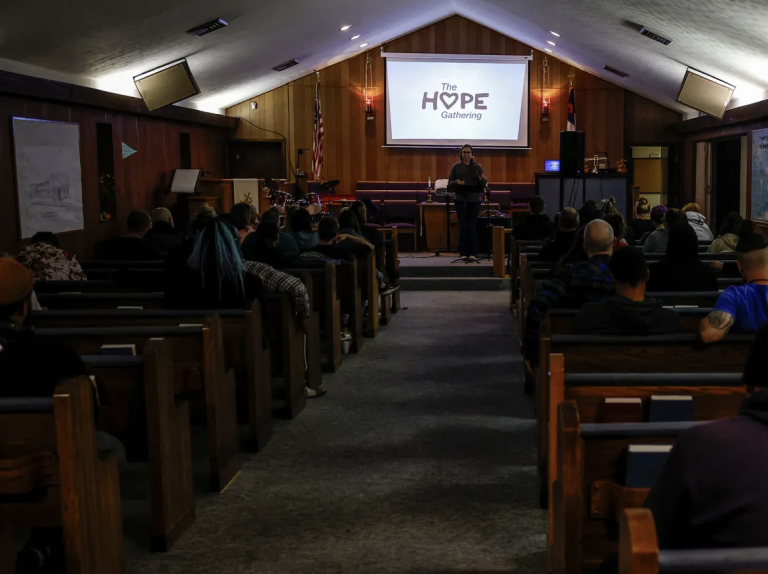MEDIA ANOMALY: ELEMENTS OF ACCURATE REPORTING ON THE OPIOID CRISIS – AND OMISSIONS THAT PERPETUATE LETHAL HARM
Yes, naloxone saves have caused the recent, dramatic drops in opioid fatal overdose – despite persistently mounting high-risk use and overdose due to expert treatment failure
by Clark Miller
Published May 30, 2025
The story appearing late last year is by Reuters reporters Maurice Tamman and Shannon Stapleton, published in USA Today’s December 21, 2024 edition.
COLUMBUS, Ohio – The death toll from fentanyl and other synthetic opioids is falling for the first time since the drugs began flooding America’s streets a decade ago. Users and police in this city’s beaten-down Hilltop neighborhood credit another drug flooding the United States: the overdose antidote naloxone.
James “Sleaze” Morgan says naloxone has saved him after overdosing – as many as 20 times in the last several years.
The lifesaving nasal-spray medicine is everywhere in the 10 or more Hilltop “trap” houses where users come to buy and take fentanyl. Distributed free by local officials, supplies are abundant at the house where Sleaze smokes fentanyl and works security in exchange for drugs.
Yes, that’s the accurate picture of what is established by analyses as having been occurring – actually over past years and as early as 2018 in Ohio – consistently across diverse states and locales where opioid overdose deaths have dramatically dropped only and when intensive, targeted, community-level naloxone campaigns get training and units where they are most effective, in the possession of laypersons who can respond immediately to a potentially fatal opioid overdose. Those analyses, here, provide the evidence establishing that in those diverse locales consistently, the year-to-year increases in magnitude of successful saves due to those campaigns more than account for numbers of reduced opioid OD deaths.
Additional analyses – for example here and here – establish that the few states considered anomalous in that widespread pattern, lagging other states in the moderate to dramatic OD death reductions over the past years, are in fact exceptions that prove the rule – reductions corresponding to initiation of effective naloxone campaigns.
Dr. Rahul Gupta, director of the White House Office of National Drug Control Policy, says a federal effort to get naloxone and other addiction treatments into communities is driving the steady decline in overdose deaths. Prosecutions of fentanyl suppliers and the drug’s ingredient makers have disrupted the entire supply chain, he adds, resulting in less potent fentanyl on the streets.
[emphasis added]
Naloxone of course is not another “addiction treatment” any more than automated external defibrillators (AED) are “treatments” for heart disease. Naloxone is the AED of the opioid crisis, desperately required in intensive campaigns to prevent and moderate persistently mounting sudden deaths by emergency reversals in an epidemic of persistently increasing incidence of high-risk use and otherwise fatal episodes.
An intervention that has “disrupted the entire supply chain” of fentanyl would of course provide very different patterns of outcomes than what is evident – highly variable by locale and still driven by fentanyl.
But the stories of Sleaze and other users in Columbus show how even with a powerful antidote on the streets, it’s proving difficult to break fentanyl’s grip on America.
Difficult and predictable, no mystery, the forces driving the crisis and perpetuating increasing high-risk opioid use and overdose – requiring those desperate naloxone campaigns – clear from the beginning of the crisis, as we have seen.
Scott Sanders is executive director of the Hope Resource Center, a haven and support provider for Sleaze and other users in the Hilltop area of Columbus. He hands out roughly 1,000 naloxone kits a month, each with two nasal-spray canisters. But while naloxone is saving lives, Sanders says, the number of substance abusers on Hilltop’s streets is growing.
Visits to Hope’s drop-in center have risen about a third this year, to about 18,300 in the 12 months through November 2024, up from about 13,400 in the prior 12 months.
“And that scares me to death,” Sanders says. “Because all the powers that be are going to be throwing parties. Like, wow, look, it’s not a problem anymore,” he says of the fatality trendline. “But we’re busier than ever.”
And you will continue to become busier and busier, and we know exactly why.
Intensive, successful naloxone campaigns are desperate emergency measures to reduce deaths due to high-risk opioid use, do nothing to reduce the high-risk use resulting in overdose.
Persistently increasing high-risk use and overdose are predictable, driven by lethal failure of expert gold standard medical and other “treatments” that have been increasingly dispensed and provided over decades of worsening substance use epidemics.
Those sham treatments are established as providing no benefit, instead driving substance use epidemics, with no reasons to expect different outcomes.

A variety of speculative explanations for the recent drops in opioid OD deaths are described in the piece including changes in potency of fentanyl on the street, belied by results from research labs –
Some scientists familiar with the DEA study are skeptical that its results reflect the drugs on the streets. Different samples they’ve tested at their own labs show that drugs being sold to users contain as much fentanyl as ever.
and the speculation that adulterants appearing in fentanyl over the past few years – powerful animal tranquilizers like xylazine (“tranq”) and more recently medetomidine – affect fentanyl intoxication by increasing psychological half-life, reducing the frequency of administration and thereby risk of overdose –
Today, some health researchers theorize there’s a silver lining in the presence of these dangerous tranquilizers. They appear to have the potential to reduce opioid overdoses.
Fentanyl is extremely addictive. Users need more fixes a day than with heroin or other opioids. It delivers a fleeting high, often only an hour or two for experienced takers, so users soon crave another hit. Xylazine and sister drugs are longer-lasting anesthetics that delay opioid withdrawal, so users need fewer fixes – and thus take fewer rolls of the dice with death.
or that opioid OD deaths have recently finally dropped, dramatically, because death rates have been so high that there simply are many fewer users alive to die –
Charles Fain Lehman, a fellow specializing in policing and public safety at the Manhattan Institute think tank, offers another explanation for the fatality trend: the “depletion of susceptibles.”
Lehman cites surveys that show young Americans are shying away from hard drugs, with consumption of narcotics by high school seniors now at one-fourth its peak in the 2000s. He also points to the vast number of synthetic opioid overdose deaths in recent years as reason to believe the population of at-risk people is way down.
Only so many people ever use narcotics, leaving “a fixed population of people who are at risk for overdose death,” Lehman says. “To be a little morbid, if you die early, you can’t die later.” Because of the high “burn rate” of people dying in recent years, he argues the U.S. toll has begun trending down as the susceptible population has shrunk.
Nor account for drops that are very specific to locale , by county for example in Florida or in San Francisco, with no apparent significantly diminished population of “suseptibles”.
Sam Rivera, executive director of OnPoint NYC, a support center for substance abusers and other vulnerable people, says opioid users have long had strategies for keeping dope sickness away. In what’s commonly called “speedballing,” users will take a stimulant such as methamphetamine or cocaine to “balance” an opioid high and delay the desire for another fix.
They have indeed “long had strategies”, as has been repeatedly described for decades, as long as the “proven“, gold standard medical opioid cure buprenorphine (Suboxone) – among the most commonly available street drugs – has been functioning in illicit street drug economies as currency for fentanyl, commodity, consumable, urine screen hack, and “bridge”, enabling continuing fentanyl use by easing withdrawal discomfort over periods of no use, for whatever reason, until planned return to use. The high value, safety, availability and other features of prescribed Suboxone enhancing its use in street economies of high-risk drug use are covered here and elsewhere here.
That the role of “bupe” in those illicit economies and perpetuation of the opioid crisis is not mentioned in this piece is a glaring omission with lethal consequences.
The reporting is anomalous in ways that provide important exposure of truths,
of rents, fissures in the Matrix: that the unsupported speculations to explain recent drops in opioid OD deaths as alternatives to the clear causal relationship with naloxone saves serve only as distracting mystifications; that on the streets, in communities, in real lives, the roots of compulsive opioid and drug use lie in (generally early, childhood) psychologically injurious experiences; and that while emergency naloxone reversal campaigns to stem the tide of fatal overdoses are successful, accounting entirely for recent drops in fatal ODs, their very necessity, along with consistently confirming evidence, further reinforces the established roles of expert treatment approaches as lethally failed, fueling the crisis.
What’s left, omitted from the reporting, is the inescapable conclusion, established for years, that the trends in deaths, emergency saves, persistently mounting high-risk use, and nonfatal overdose point unequivocally to lethal failure of gold standard expert addiction treatments.

That omission represents the obvious truth that can’t be spoken, is forbidden, too big and disruptive to be expressed, the costs of staying hidden be damned.
Our trusted institutions must remain trusted and protected, no matter how absurd, revelatory, and transparent the evidence in front of our eyes. No matter how obviously our demands for explanation and accountability should have been triggered, and have not been, by the funding of a $350 million NIH study completed last year to generate outcome measures supporting effectiveness of the medical “proven” gold standard cures for high-risk opioid use, “evidence based” treatments that have been asserted by unified medical/media consensus for decades as already established as highly effective, as providing 50 percent reductions in opioid overdose deaths when provided.
What was the need for another study? For the medical treatment established as the “gold standard” and saving lives for decades? Why not get more of that medical cure administered to the diseased brains, using the $350 million? Think of all the lives to be saved.
And the results of that study? And the post hoc, secondary analyses of results? Those are explained here and here – showing that, incontrovertibly, America’s gold standard expert treatments cannot be contributing to recent drops in opioid deaths, instead are contributing to them.
That’s the story here. Waiting, against fear and reckless deaths, to be exposed.
“Crisis is a necessary condition for a questioning of doxa, but is not in itself a sufficient condition for the production of a critical discourse.”
– Pierre Bourdieu Outline of a Theory of Practice (1972)
In Bourdieu’s Theory of Practice, heterodoxy is dissent, challenge to what “goes without saying” – the accepted, constructed doxa, “knowledge”, reality, that goes without saying precisely because it “comes without saying”, without real scrutiny, untested, unquestioned. The function of doxa is not knowledge or truth or promotion of the collective good, but to protect and serve the interests of those with the power, the cultural capital, to create it.









